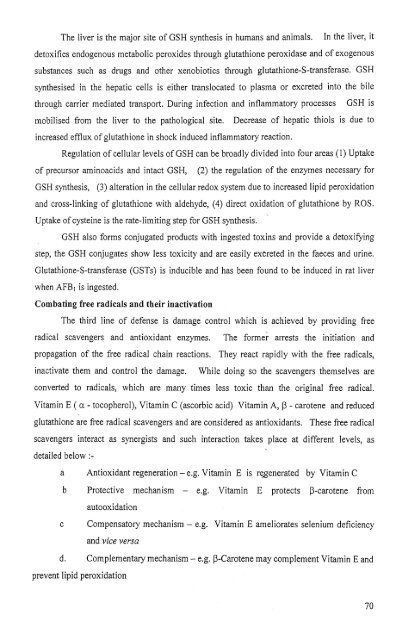, Diagnosis an-&& of Shrimp Diseases - Central Institute of ...
, Diagnosis an-&& of Shrimp Diseases - Central Institute of ...
, Diagnosis an-&& of Shrimp Diseases - Central Institute of ...
- No tags were found...
You also want an ePaper? Increase the reach of your titles
YUMPU automatically turns print PDFs into web optimized ePapers that Google loves.
The liver is the major site <strong>of</strong> GSH synthesis in hum<strong>an</strong>s <strong>an</strong>d <strong>an</strong>imals.In the liver, itdetoxifies endogenous metabolic peroxides through glutathione peroxidase <strong>an</strong>d <strong>of</strong> exogenoussubst<strong>an</strong>ces such as drugs <strong>an</strong>d other xenobiotics through glutathione-S-tr<strong>an</strong>sferase. GSHsynthesised in the hepatic cells is either tr<strong>an</strong>slocated to plasma or excreted into the bilethrough carrier mediated tr<strong>an</strong>sport. During infection <strong>an</strong>d inflammatory processesGSH ismobilised from the liver to the pathological site.Decrease <strong>of</strong> hepatic thiols is due toincreased efflux <strong>of</strong> glutathione in shock induced inflammatory reaction.Regulation <strong>of</strong> cellular levels <strong>of</strong> GSH c<strong>an</strong> be broadly divided into four areas (1) Uptake<strong>of</strong> precursor aminoacids <strong>an</strong>d intact GSH, (2) the regulation <strong>of</strong> the enzymes necessary forGSH synthesis, (3) alteration in the cellular redox system due to increased lipid peroxidation<strong>an</strong>d cross-linking <strong>of</strong> glutathione with aldehyde, (4) direct oxidation <strong>of</strong> glutathione by ROS.Uptake <strong>of</strong> cysteine is the rate-limiting step for GSH synthesis.GSH also forms conjugated products with ingested toxins <strong>an</strong>d provide a detoxifyingstep, the GSH conjugates show less toxicity <strong>an</strong>d are easily excreted in the faeces <strong>an</strong>d urine.Glutathione-S-tr<strong>an</strong>sferase (GSTs) is inducible <strong>an</strong>d has been found to be induced in rat liverwhen AFBl is ingested.Combating free radicals <strong>an</strong>d their inactivationThe third line <strong>of</strong> defense is damage control which is achieved by providing freeradical scavengers <strong>an</strong>d <strong>an</strong>tioxid<strong>an</strong>t enzymes.The former arrests the initiation <strong>an</strong>dpropagation <strong>of</strong> the free radical chain reactions. They react rapidly with the free radicals,inactivate them <strong>an</strong>d control the damage. While doing so the scavengers themselves areconverted to radicals, which are m<strong>an</strong>y times less toxic th<strong>an</strong> the original free radical.Vitamin E ( a - tocopherol), Vitamin C (ascorbic acid) Vitamin A, !.3 - carotene <strong>an</strong>d reducedglutathione are free radical scavengers <strong>an</strong>d are considered as <strong>an</strong>tioxid<strong>an</strong>ts. These free radicalscavengers interact as synergists <strong>an</strong>d such interaction takes place at different levels, asdetailed below :-aAntioxid<strong>an</strong>t regeneration - e.g. Vitamin E is regenerated by Vitamin Cb Protective mech<strong>an</strong>ism - e.g. Vitamin E protects p-carotene fromautooxidationcCompensatory mech<strong>an</strong>ism - e.g. Vitamin E ameliorates selenium deficiency<strong>an</strong>d vice versad. Complementary mech<strong>an</strong>ism - e.g. p-Carotene may complement Vitamin E <strong>an</strong>dprevent lipid peroxidation
















